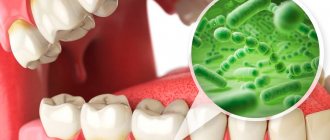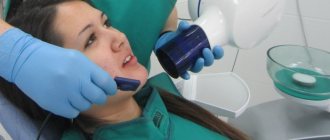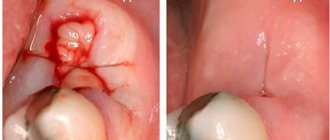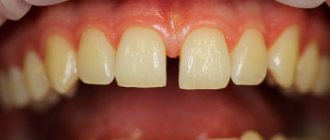The drainage system is installed in stages:
- The painful area of the jaw is numbed.
- The gum is cut and a latex drain is inserted into it, through the hole of which the pus is sucked out.
- After suctioning out the pus, an antiseptic drug is injected into the gum incision.
- If a tooth is removed, the gum is not cut, but a drain is inserted into the socket.
How many days should I wear the drainage? Improvement may occur within 24 hours. On average, drainage costs from 3 to 5 days.
What is drainage
Gum drainage has been performed by surgeons for many decades. It is a tube made of dense materials and its role in the treatment of infectious diseases can hardly be overestimated.
The invention was invented by a surgeon from France, Chassagnac. To create the structure, the doctor used glass and rubber. With the help of such a device, doctors could remove excess fluid and remaining necrotic masses from inflamed tissues. To achieve the desired effect, doctors left the tubes in the patient's body for several days.
And nowadays, surgeons use drainage during operations. However, the appearance of the devices has undergone significant changes: the tubes have become smaller and thinner in size, and modern materials are used to create them. The external drainage has changed, but all its functions have been preserved. It does not allow the incision in the gum to close prematurely; promotes the rapid removal of pus, ichor and necrotic masses from the affected areas; Helps drugs reach deep layers of soft tissue.
What drainage in soft tissues looks like in the photo
The drainage is left in the mouth until the swelling subsides. This sign indicates complete cleansing of the affected area. For speedy wound regeneration in the postoperative period, it will be necessary to use special ointments, gels and solutions for rinsing the mouth.
To create modern drainages, latex and rubber materials are used. Due to this, the patient practically does not feel discomfort when eating. Waterproof materials are firmly held in the gums and do not allow the tissues to tighten. A small section of the tube remains on the outside of the gum. Through it, pus is removed unnoticed by the patient.
Dentist advice
If you follow the doctor's recommendations, the effectiveness of the drainage system increases.
- After installing the drainage, you can eat only a few hours later. Food should be liquid.
- You can take a painkiller tablet to relieve pain.
- Drainage is installed when a purulent process occurs, so you should not apply a heating pad to your cheek. It is better to apply a cloth soaked in cool water
- It is better to sleep on the side opposite the side on which the drain is installed.
- If drainage is installed, it is better to stop smoking and drinking alcohol.
- Be careful when brushing your teeth.
- Avoid injuring the gums, as impacts can dislodge the drainage.
In order for the gums to heal well and without complications after removal of the drainage, the patient must follow the recommendations of the dentist, who can provide comprehensive assistance in the treatment of the inflammatory process that occurs at the root of the tooth or in the gum.
Stages of drainage
The procedure can only be performed by a specialist. Trimming the gums and installing a rubber tube occurs in several stages:
- Examination of the oral cavity by a dentist.
- Taking an x-ray to determine the depth of the tumor and the extent of its spread to adjacent tissues.
- Injection of an anesthetic into the problem area. Does it hurt to cut your gum? The procedure is accompanied by significant discomfort, so anesthesia is used to minimize pain.
- Resection of the seal using a scalpel.
- Cleaning the purulent cavity using antiseptic agents.
- Fixation of a rubber tube to drain pus.
Using an X-ray of the oral cavity, the doctor can examine the condition of the roots of the teeth and, if necessary, prescribe extraction of problematic units
In severe cases, the drainage is left in the oral cavity for 3-5 days, until the swelling subsides and the ichor stops oozing from the wound. The drain may fall out on its own or be removed by a doctor. If swelling and inflammation persist 5 days after the intervention, you should immediately contact your dentist.
What does drainage look like in dentistry?
The drainage system is widely used in medicine; each area has its own characteristics. In dental practice, rubber or latex structures are used, which have increased moisture resistance, elasticity, do not get wet when exposed to blood and purulent fluid, and are securely fixed in the gum incision.
Dental drainage
When choosing a material, special attention is also paid to its reaction to antiseptic treatment. The drainage system itself should not be noticeable in the wound, and should not have an irritating effect on the mucous membrane (itching, discomfort).
Rubber bands for drainage come in various sizes and thicknesses.
What to do if the drainage falls out?
What to do if the implant falls out of the gums prematurely? The answer to the question depends on the characteristics of the clinical case. If the swelling has subsided and the patient is not bothered by pain, then there is no need to contact the clinic to re-install the device. You cannot remove drainage from the oral cavity on your own even if the problem signs have completely disappeared.
Among the reasons for the installation to fall out on its own, the following should be noted:
- active rinsing of the mouth and thorough brushing of teeth;
- improper fixation of the structure over the tooth.
Re-installation is required if the gums still hurt after the rubber tube falls out. It is better if the procedure for installing the system is carried out by a doctor in a clinic. Only in rare cases do specialists allow patients to remove the drainage themselves when signs of swelling and inflammation disappear.
Blister on the gum - what is it?
The procedure is carried out independently, taking into account the rules:
- Hands are washed thoroughly with soap.
- The oral cavity is treated with antiseptic solutions.
- The tape or tube is removed in front of a mirror. Grasp the free edge of the material with your thumb and index finger.
The procedure is accompanied by minor pain and blood loss. All of these signs are normal. You cannot interrupt treatment immediately after installing the tube.
The wound left after drainage should be regularly treated with antiseptics
How to rinse your mouth? Miramistin, Chlorhexidine solution, and hydrogen peroxide solution are suitable for this purpose. The procedure is necessary to prevent recurrence of the problem.
An abscess or gumboil is treated comprehensively. Pathology cannot be treated with medications alone. Therapy should include the installation of drainage, local treatment of the affected area and physiotherapeutic procedures carried out after opening the purulent focus.
Why do they put drainage in the gums?
A drainage system is installed to remove exudate from flux, fistulas, and infected wounds. This allows the patient to be relieved of the inflammatory process. If this is not done, the abscess will go deep inside, causing serious conditions.
Drainage in the gum
Indications for gum drainage:
- swelling of the mucous membrane;
- purulent abscess under the molar;
- complications after wisdom tooth removal due to improper actions of the dentist or non-compliance with the doctor’s recommendations;
- periostitis of the jaw, or gumboil;
- alveolitis - infection and inflammation of the socket that occurs after tooth extraction, accompanied by severe pain;
- cyst;
- phlegmon;
- granuloma.
Gum drainage allows you to introduce prescribed medications directly into the periodontal tissue (for example, antibacterial drugs, antiseptics for washing tooth roots). This manipulation speeds up treatment, makes it effective, and reduces possible infection of the body.
Incision healing time
How long will it take for the gums to heal after drainage is removed from it? On average, tissue regeneration takes 1-2 weeks. The process largely depends on the complexity of the previous operation and the individual characteristics of the patient. For example, in older people, wounds take longer to heal. This fact is explained by the slowdown of metabolic processes with age.
Complete gum regeneration may take more than 6 months. The wound healing process after opening the abscess takes place in several stages:
- the formation of a blood clot that protects the wound from the introduction of pathogenic microorganisms;
- formation of new granulation tissue (within 3-4 days from the moment of intervention);
- maturation of new epithelium (7-10 days from the moment of opening of the purulent focus);
- soft tissue regeneration;
- formation of young bone tissue.
After the operation, the dentist gives the patient a number of instructions that help maintain drainage in the gums and avoid the development of complications after the intervention. In the first 3-4 hours after the procedure, it is prohibited to consume food. During treatment, it is advisable to redistribute the chewing load to the healthy side of the jaw. Doctors also advise giving preference to dietary products.
In the postoperative period, it is necessary to avoid intense physical activity and avoid visiting saunas, swimming pools and baths. It is also important to give up bad habits - smoking and drinking alcohol.
Is it possible to cure an abscess at home?
Patients with acute conditions are admitted to dentistry without a queue. Therefore, if your health worsens, you should not postpone your visit.
The first question that a patient has is: why does pus appear in the gums and how to treat the pathology? The cause of infiltration is a weakened immune system and non-compliance with dental care measures. At the first symptoms of inflammation, you should immediately consult a dentist. Self-opening of a flux neoplasm threatens the addition of a secondary infection.
It is strictly forbidden to heat the inflamed area. Heat activates purulent-necrotic processes and accelerates the spread of infectious agents.
Timely sanitation of the inflammatory focus in a clinical setting prevents complications.
Are there any contraindications
As with any dental procedure, the procedure in question also has a number of its limitations. Among the contraindications to fixing the drainage are problems with blood clotting - in such cases, doctors try to avoid dissecting soft tissues altogether. It will also be very difficult to carry out this procedure if the patient suffers from an allergy to anesthetics.
Purulent and bloody discharge must be removed from the wound. Without this simple device it is simply impossible to cure most diseases. One way or another, the procedure must be carried out, since this is a mandatory prevention of the development of sepsis - a general infection of the body.











